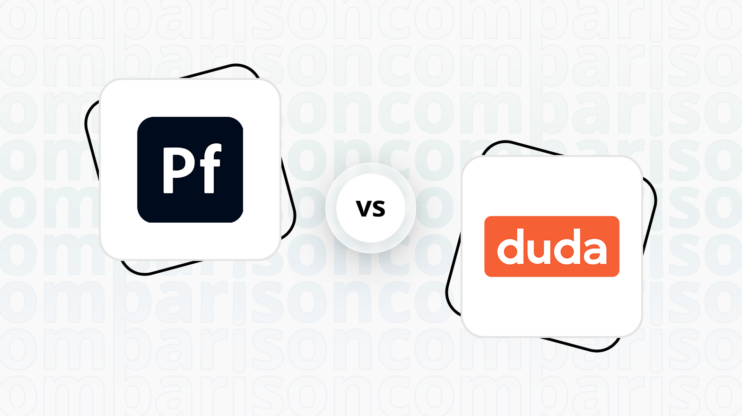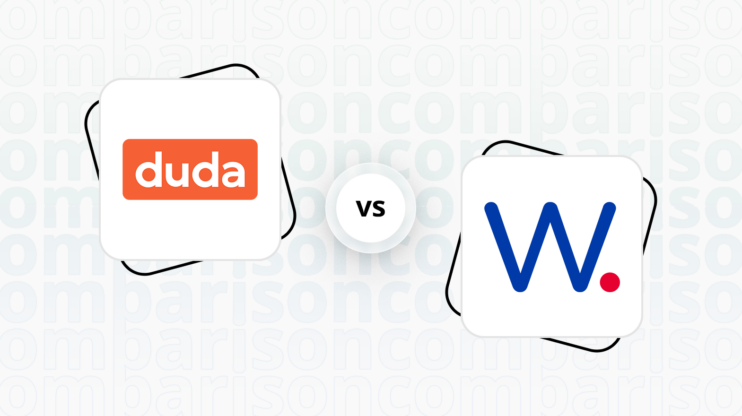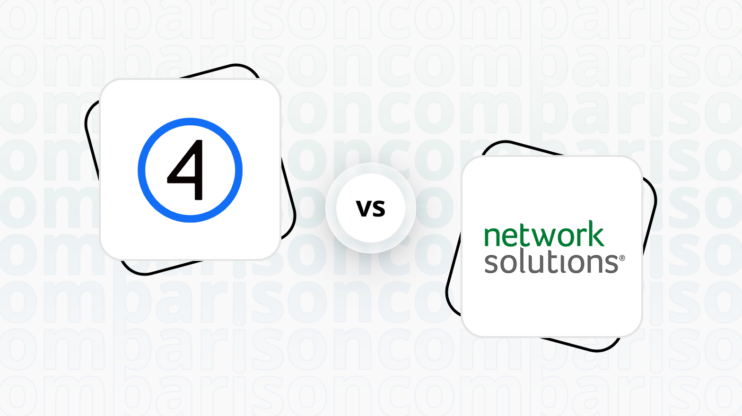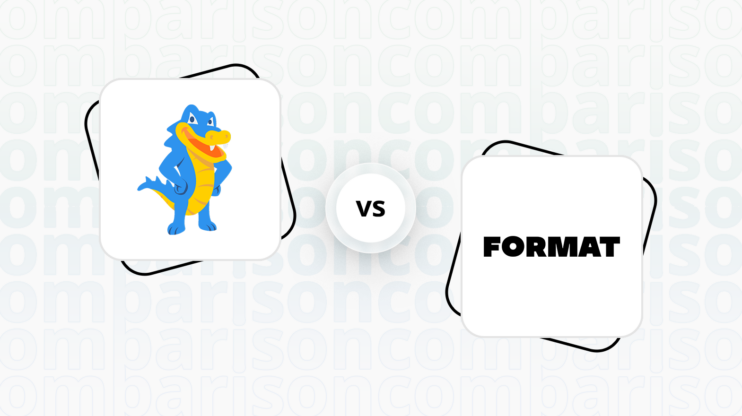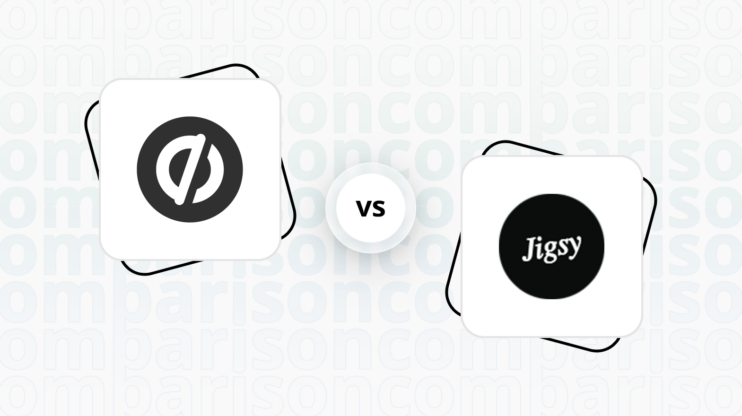Final verdict
Shopify and Sellfy both offer unique advantages, but they cater to different types of users and business needs.
-
Shopify (Overall Grade: 8.1/10)
is a comprehensive ecommerce platform ideal for businesses looking to scale. It excels in providing advanced ecommerce features, robust security, and extensive integrations. Shopify’s powerful tools for inventory management, multi-channel selling, and detailed analytics make it a top choice for serious online retailers. However, it has a steeper learning curve compared to Sellfy, which might be challenging for beginners. -
Sellfy (Overall Grade: 6.0/10)
is tailored for creators and small businesses looking for a simple, user-friendly platform to sell digital and physical products. It offers a straightforward setup process and essential ecommerce features without transaction fees. While it lacks the advanced customization and marketing tools of Shopify, Sellfy’s ease of use and focus on digital products make it a great option for creators who want to quickly set up an online store without dealing with complex configurations.

|

|
|
|---|---|---|
|
Design functionalities & templates |
8.2 |
5.2 |
|
Ease of use |
7.5 |
7.8 |
|
Ecommerce |
9.2 |
6.8 |
|
Website Editors |
7.9 |
6.8 |
|
Product testing options |
8.1 |
7.3 |
|
Price |
8.2 |
7.9 |
|
Hosting quality |
9.0 |
7.3 |
|
Website speed optimization |
7.8 |
5.4 |
|
Plugins and integrations |
8.7 |
6.7 |
|
Marketing features |
8.8 |
7.1 |
|
Customer support |
8.6 |
5.8 |
|
Security |
9.0 |
7.2 |
|
AI capabilities |
7.9 |
0 |
|
User Management |
6.5 |
2.0 |
Best for ecommerce
 9.2
9.2
 6.8
6.8
Verdict
: Sellfy is excellent for creators and small-scale operations, while Shopify excels in scalability and comprehensive ecommerce features.
-
Shopify
: Known for its extensive ecommerce capabilities, Shopify is ideal for businesses aiming for growth. It supports a wide range of ecommerce functions, making it the go-to platform for those looking to scale. However, when comparing Shopify vs Sellfy, Shopify might be overwhelming for beginners due to its extensive features. -
Sellfy
: Its user-friendly interface is perfect for creators and those starting out. The platform offers a range of tools suitable for selling digital, physical, and subscription-based products. However, it may fall short for complex inventory needs and advanced marketing capabilities.
Best for informational & business websites
 6.8
6.8
 5.7
5.7
Verdict
: When it comes to creating informational and business websites, Shopify and Sellfy each have their own strengths, but Shopify edges out Sellfy with a slightly higher score.
-
Shopify
: Shopify, scoring 6.8, is primarily an ecommerce platform but can be adapted for informational websites. Its robust design functionalities and templates offer a professional look, although the learning curve can be steep for those new to website building. Shopify’s extensive learning resources and 24/7 customer support make it a reliable choice for businesses that may need ongoing assistance. -
Sellfy
: Sellfy, with a score of 5.7, is tailored for creators looking to sell various products, including digital and physical items. Its user-friendly interface and straightforward setup make it accessible for beginners. However, it lacks the advanced design customization and extensive support resources that Shopify offers. Sellfy is best suited for creators who prioritize ease of use and quick setup over advanced features.
Detailed comparison
Design functionalities & templates
Design FunctionalitiesRepresents how well each platform allows for creative design and customization of websites.Score Components:
- Template Variety (30%): Range and quality of design templates.
- Customization (30%): Flexibility and options for design alterations.
- User Interface (20%): Ease and intuitiveness of the design process.
- Responsiveness (10%): Adaptability to different devices and screen sizes.
- Innovation (10%): Unique design features and tools.
 8.2
8.2
 5.2
5.2
Winner: Shopify.
If you’re looking for a platform that offers more advanced and diverse design functionalities and templates, Shopify is the preferred choice.
Shopify’s templates are sleek and professional, ideal for ecommerce sites. They offer a sophisticated look with a focus on online stores. While the free template selection is not large, Shopify’s premium theme store provides a variety of industry-specific options, offering advanced features for a strong brand presence.
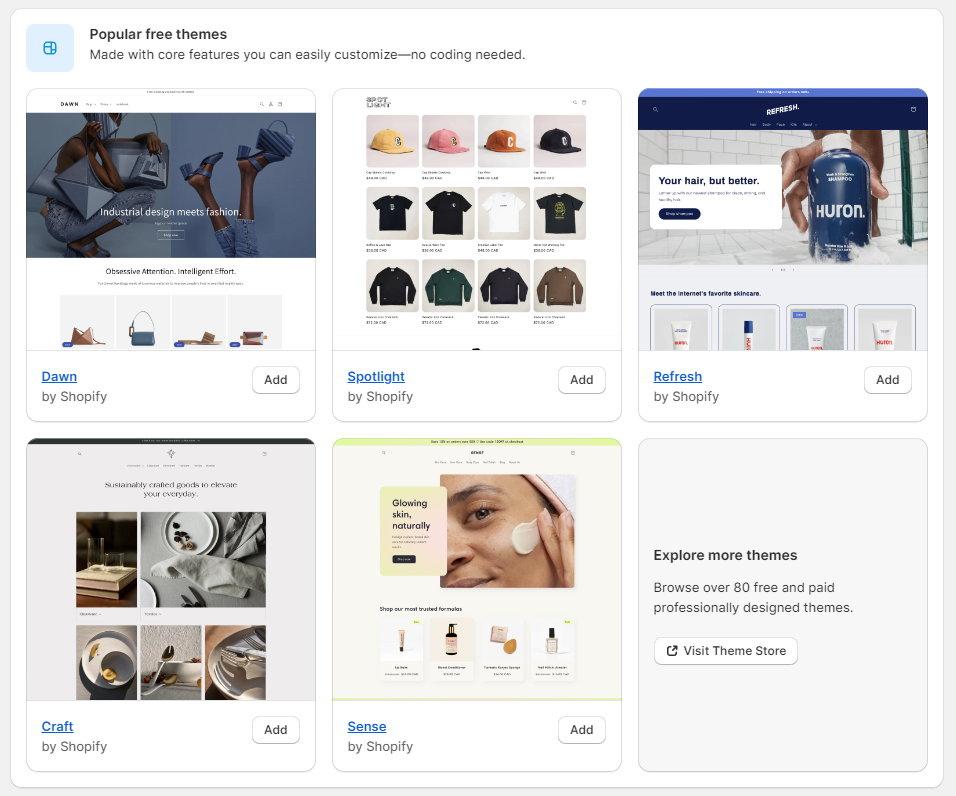
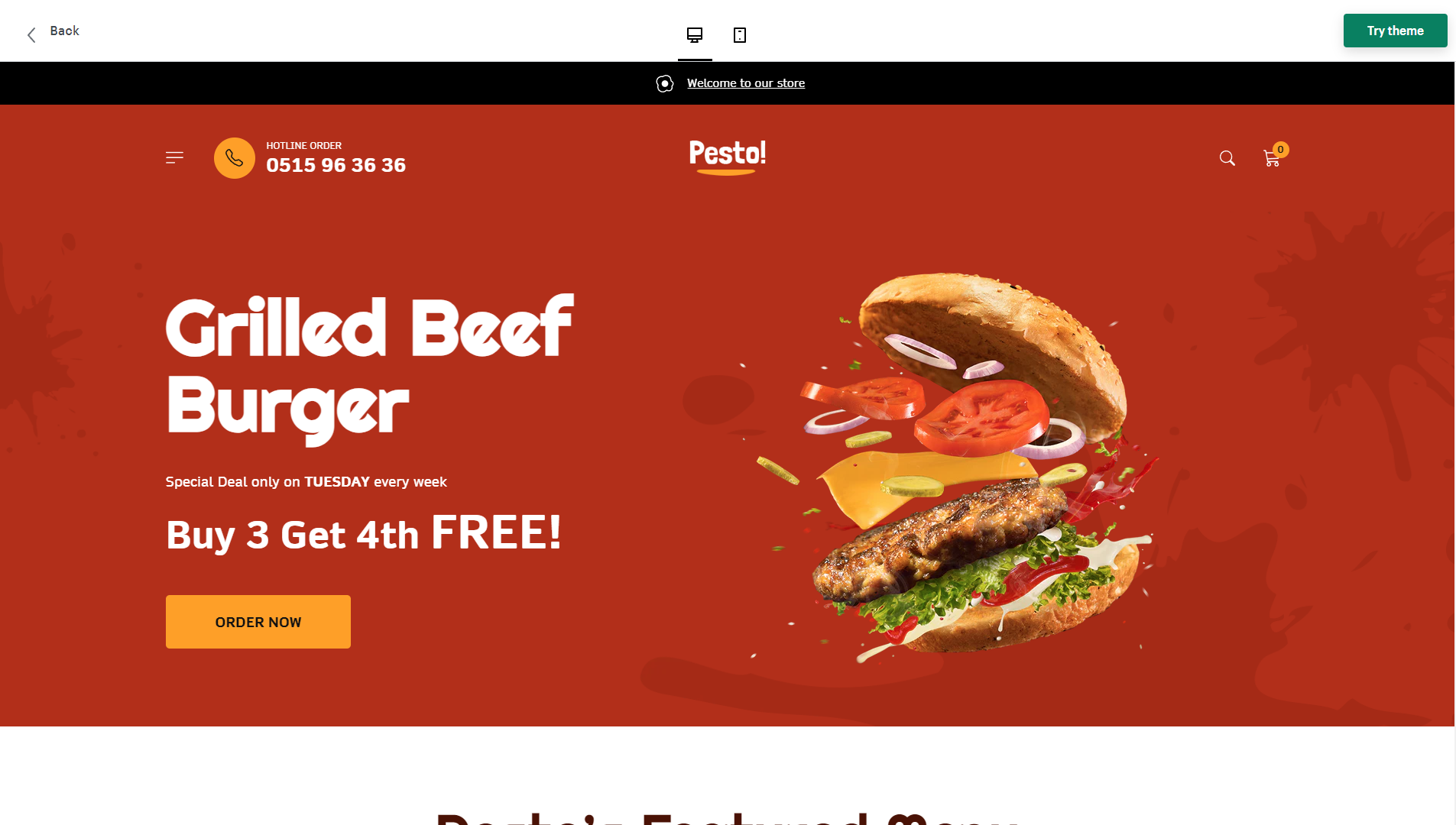
Compared to Shopify, Sellfy provides a collection of design templates through its theme store, located in the Store Customizer. Users have the option to preview these themes before applying them to their websites. As of the latest information, Sellfy offers five main theme options: Lumiére, Noir, Savant, Idée, and Mode. These themes cater to various aesthetic preferences and can be published to go live on a user’s website after selection and customization.
Get a head start on website creation with AI
Create a custom website tailored to your business needs 10X faster with 10Web AI Website Builder!
Ease of use
Ease of useReflects the platform’s overall user-friendliness.Score
Components:
- Learning curve (40%): Quickness and ease of getting started.
- Interface design (30%): Simplicity and intuitiveness of layout.
- User guidance (20%): Quality of tutorials and support.
- Flexibility (10%): Adaptability to various user skills.
 7.5
7.5
 7.8
7.8
🏆 Winner: Sellfy
. With a score of 7.8, Sellfy edges out Shopify (7.5) in terms of ease of use. Sellfy’s user-friendly interface and straightforward website builder make it accessible for creators and small business owners without advanced technical skills. Shopify, while also user-friendly, has a steeper learning curve, especially for those new to ecommerce.
Learning Resources
🏆 Winner: Shopify
. Shopify provides an extensive library of articles, tutorials, webinars, and video courses, focusing primarily on setting up and managing online stores. Sellfy, on the other hand, lacks a large community of users and does not have a community forum, which could limit the availability of peer support and shared learning resources.
For ecommerce
EcommerceMeasures the platform’s effectiveness in supporting online business activities.Score Components:
- Ecommerce themes and templates (20%): Variety and design of templates.
- Product management (25%): Ease of managing and organizing products.
- Payment options (25%): Variety and convenience of payment methods.
- Ecommerce features (20%): Features for managing an ecommerce store.
- Integration (10%): Compatibility with external e-commerce tools and services.
 9.2
9.2
 6.8
6.8
Shopify and Sellfy are both ecommerce platforms, but they cater to different needs. Shopify is a comprehensive ecommerce platform that provides a wide range of features for online businesses, including a comprehensive store builder, advanced inventory management, multi-channel selling, abandoned cart recovery, and detailed analytics and reporting. It’s ideal for businesses that need a robust and scalable ecommerce solution.

|

|
|
|---|---|---|
|
Ecommerce themes and templates |
8.2 |
7.0 |
|
Product page customization |
8.5 |
6.5 |
|
Payment processing and commissions |
8.8 |
8.0 |
|
POS capabilities |
8.1 |
4.0 |
|
Payment gateways |
9.5 |
6.0 |
|
Product numbers |
9.0 |
7.5 |
|
Additional ecommerce features |
9.1 |
6.5 |
Shopify ecommerce features:
- Comprehensive store builder
- Shopify Payments and other gateways
- Advanced inventory management
- Multi-channel selling
- Abandoned cart recovery
- Detailed analytics and reporting
On the other hand, Sellfy is a user-friendly ecommerce platform designed for creators selling a variety of products, including digital goods, physical products, and subscriptions. It offers a streamlined selling experience with no transaction fees, but its simplicity may limit customization and advanced marketing capabilities.
Sellfy ecommerce features:
- Product Listings
- Payment Gateways integration
- Product categories
Ecommerce themes & templates
Shopify offers about 150 modern and responsive themes for creating a virtual storefront, ensuring a good look on both desktop and mobile devices. While some themes are free, others cost between $170 to $380. Sellfy, on the other hand, offers templates designed specifically for online stores.
Product page customization
Shopify allows for three options per product, totaling 100 unique variations. While Shopify offers titles, descriptions, and image galleries with zoom effects, customization options like adding ribbons, size charts, and wishlists are not as straightforward. However, Shopify distinguishes itself with additional features through its extensive library of extra apps, offering functionalities like reviews, Facebook stores, eBay item importers, and a unique Augmented Reality feature for an enhanced customer experience.
Sellfy supports a diverse range of products including digital goods like music, videos, ebooks, and software, as well as physical products and print-on-demand merchandise such as t-shirts and mugs. The platform enables the sale of subscriptions, offering a means for recurring revenue. Sellfy provides tools for product protection and piracy prevention, ensuring secure file hosting and delivery.
Payment processing
Shopify offers payments with typical charges of 2.9% + 30¢ per online transaction on basic plans, and lower fees for higher-tier plans. However, it adds extra fees for using other payment gateways. Shopify Payments is Shopify’s own payment processing gateway. It allows merchants to accept credit card payments directly on their store without having to integrate third-party payment providers. This simplifies the payment process, reduces transaction fees, and streamlines the handling of finances.
Sellfy supports two primary payment gateways, Stripe and PayPal, allowing for various payment options including credit/debit cards and localized payment methods in Europe. The platform does not charge transaction fees beyond its subscription cost, though payment processors’ standard fees apply. While Sellfy is robust in facilitating online sales with features for product management and marketing, it does not explicitly mention support for Point of Sale (POS) capabilities, indicating a focus on eCommerce rather than physical retail transactions.
Website Editors
Website EditorsEvaluates the platforms’ website building and editing capabilities.Score Components:
- Customization tools (40%): Range and power of editing features.
- Editor usability (30%): User experience within the editor.
- Design flexibility (20%): Freedom in layout and design changes.
- Update and maintenance ease (10%): Simplicity of updating and maintaining the site.
 7.9
7.9
 6.8
6.8
🏆
Winner: Shopify
. Shopify’s editor, scoring 7.9, excels in providing a streamlined, ecommerce-focused editing experience. It’s particularly beneficial for users who prioritize efficient management of online stores. The editor is straightforward, making it easy to add products, manage inventory, and set up payment methods. Shopify’s editor is optimized for sales and business growth, with built-in tools specifically designed for ecommerce businesses.
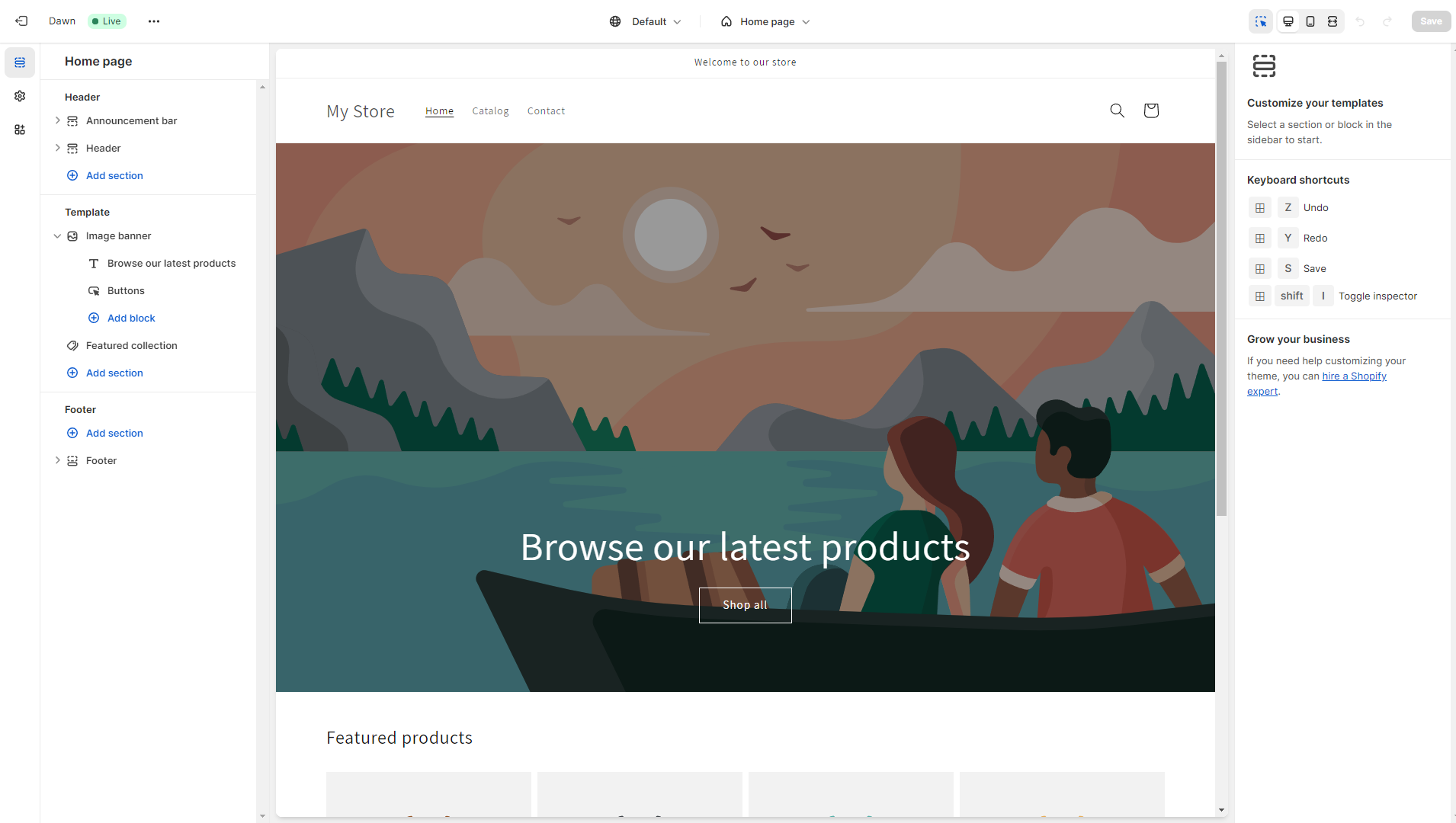
Sellfy’s editor, scoring 6.8, offers a straightforward and user-friendly platform for creating online stores, focusing on simplicity over advanced customization. It supports the sale of digital, physical, subscription-based, and print-on-demand products, alongside integrated marketing tools for promotion and sales optimization. Despite some limitations in design customization and app integrations, Sellfy aims to provide a comprehensive e-commerce solution for entrepreneurs and creators.
Mobile editor/app
 8.0
8.0
 7.5
7.5
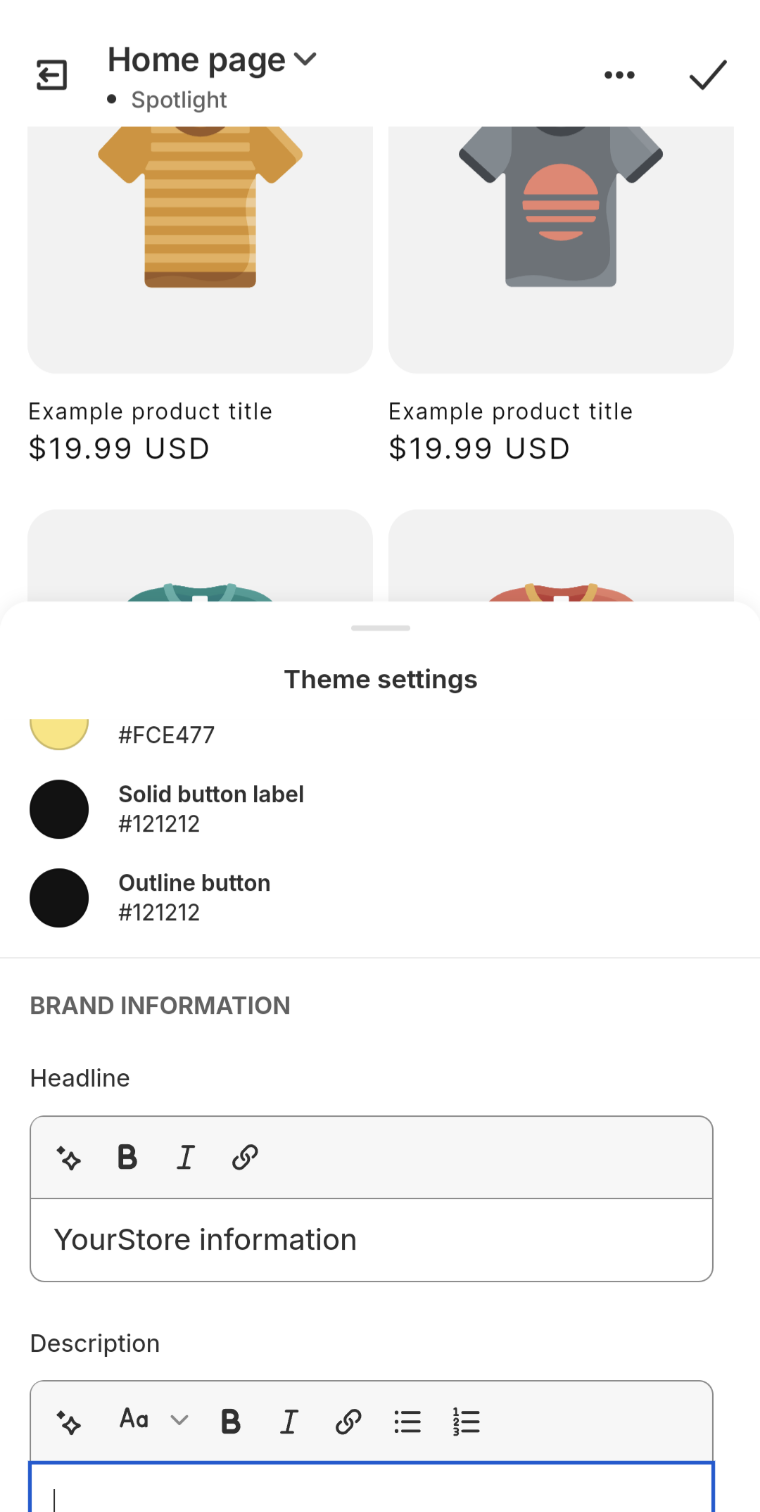
🏆
Winner: Shopify
. Both Shopify and Sellfy offer mobile apps for managing your online store, but they cater to different needs. Shopify’s mobile app includes a user-friendly mobile theme editor that allows users to customize their online store website directly from their mobile device. This feature enables the addition, removal, editing, and rearrangement of content on the store’s website, offering convenient on-the-go adjustments to the store’s appearance and layout.
Sellfy, on the other hand, enables store owners to manage their online stores on the go, offering functionalities such as viewing store performance metrics, managing and tracking orders, and receiving customized notifications. However, it’s not possible to change the layout or the design of the website itself through the Sellfy mobile app.
In summary, while both platforms offer robust mobile management capabilities, Shopify’s mobile app provides more comprehensive editing features, earning it a higher mobile editor score.
Product testing options
Product Testing OptionsAssesses the options for trying out platform features before commitment.Score Components:
- Trial quality (40%): Extent and usefulness of the trial or free version.
- Feature accessibility (30%): How many features are available to test.
- Trial duration (20%): Length of the trial period.
- Ease of transition (10%): Smoothness of moving from trial to paid plans.
 8.1
8.1
 7.3
7.3
Overall Result
:
Shopify wins
. Shopify scores 8.1 in product testing options, while Sellfy scores 7.3. Both Shopify and Sellfy offer a 14-day free trial, but Shopify allows testing of all features during the free trial, providing a more comprehensive evaluation.

|

|
|
|---|---|---|
|
Free Plan |
No | No |
|
Trial Duration |
14 days | 14 days |
|
Testing Premium Features |
All features during free trial |
During the free trial |
|
Money Back Guarantee |
No (14-day free trial) |
Yes (30-day money back guarantee) |
Price
PriceLooks at the cost-effectiveness and value for money of each platform.Score Components:
- Plan value (40%): What each pricing tier offers.
- Transparency and clarity (30%): Clearness of pricing structures.
- Flexibility of plans (20%): Range of options to suit different budgets.
- Hidden costs (10%): Additional expenses not included in the plan.
 8.2
8.2
 7.9
7.9
Shopify and Sellfy both offer a 20% discount on annual subscriptions. However, Shopify has a higher price score and offers enterprise plans for high-growth businesses and large enterprises, while Sellfy does not have an enterprise plan.

|

|
|
|---|---|---|
|
$20-$30 |
Shopify Basic ($29/month): Unlimited products, 2.9% + 30¢ card fee with Shopify payments, Extra 2% gateway fee without Shopify Payments, Abandoned cart recovery, Automated sales tax, Digital products, POS Integration, 2 staff accounts. Value for price: 8.0 |
Starter ($29/month): Ideal for growing businesses with sales up to $10k/year. Offers unlimited products, digital and subscription products, domain connection, and 2,000 email credits. Annual savings available. Value for price: 7.5 |
|
$70-$80 |
Shopify Standard ($79/month): Lower card fees (2.6% + 30¢), Gift cards, Professional reports, 5 staff accounts. Value for price: 8.5 |
Business ($79/month): Targets businesses with up to $50k in yearly sales, offering everything in the Starter plan plus 10,000 email credits, product and store design migration, product upselling, cart abandonment tools, and Sellfy branding removal. Value for price: 8.0 |
|
$100+ |
Advanced Shopify ($299/month): Lowest card fees (2.49% + 30¢), Advanced report builder, Real-time carrier shipping, Up to 15 staff accounts Value for price: 8.8 |
Premium ($159/month): For businesses with up to $200k/year in sales. Includes everything in the Business plan plus 50,000 email credits, product migration, and priority support. Annual savings are also offered. Value for Price: 8.5 |
location. As a result in rare cases the prices displayed here can differ from the ones you see on their
websites.
Hosting quality
Hosting
qualityExamines the reliability and performance of the hosting solutions.Score Components:
- Uptime (40%): Consistency and reliability of website availability.
- Speed (30%): Loading times and performance.
- Bandwidth and storage (20%): Sufficiency of resources provided.
- Data centers (10%): Quality and distribution of hosting infrastructure.
 9.0
9.0
 7.3
7.3
🏆
Winner: Shopify
Shopify’s proprietary cloud-based hosting, with a 99.99% uptime guarantee and five global data centers, is designed for high-traffic online stores. Sellfy also offers hosting with a 99.99% uptime, but it does not provide a guarantee or disclose its hosting type and data center locations. This lack of transparency results in a lower rating for Sellfy.

|

|
|
|---|---|---|
|
Do they offer hosting? |
Yes, included in all paid plans |
Yes |
|
Data Centers: |
5 globally: USA (Ashburn, Virginia; Santa Clara, California), Canada (Toronto, Ontario), Ireland (Dublin), and Singapore |
Not disclosed |
|
Type of hosting: |
Proprietary cloud-based hosting |
Not disclosed |
|
Uptime: |
99.99% |
99.99% |
|
Uptime Guarantee: |
Yes, 99.99% |
No |
Website Speed Optimization
Website Speed OptimizationEvaluates optimization of website loading timesScore Components:
- PageSpeed Score (30%): Google’s score indicating performance optimization.
- Loading Time (30%): The average time until a website is fully interactive.
- Mobile Optimization (15%): Optimization effectiveness for mobile devices.
- Resource Optimization (15%): Optimizing images, scripts, and other heavy resources.
- CDN Usage (10%): Use of CDN to enhance speed across geolocations.
 7.8
7.8
 5.4
5.4
🏆 Winner: Shopify
Both Shopify and Sellfy prioritize website performance and page speed, but Shopify has a higher score in this area, indicating better performance.

|

|
|
|---|---|---|
|
Focus |
App optimization, Google AMP |
Code Minification, Caching, Image Optimization |
|
Performance Tools |
Google Lighthouse, PageSpeed Insights |
Not specified |
|
Key Strategies |
App efficiency, Theme optimization |
Code Minification, Caching, Image Optimization |
|
Load Times |
Varies widely, dependent on optimization |
Varies depending on optimization and website complexity |
|
Page Speed Scores Range |
Scores vary; influenced by apps, images |
Not specified |
|
Core Web Vitals Improvement |
Emphasis on LCP, FID, CLS improvements |
Not specified |
Shopify places a strong emphasis on website performance and page speed. Its approach to enhancing site speed includes app optimization by removing unneeded app code, conditionally loading apps, avoiding immediate pop-up displays, and incorporating app functionality directly into themes. This approach leverages Shopify’s fast servers and CDN network to boost load speed. Shopify also suggests utilizing Google AMP for faster mobile page loads, although with some design compromises. Analysis of three Shopify sites showed a range of Shopify speed scores from 14 to 75, Google PSI scores from 8 to 80, and load times varying from 10.6 seconds to 2.3 seconds. Continuous maintenance and optimization are essential for keeping Shopify stores fast.
Sellfy, on the other hand, uses code minification, caching, and image optimization as its key strategies for speed optimization. However, it does not provide any specific information on its performance tools, load times, PageSpeed score ranges, or improvements in Core Web Vitals. This lack of transparency may make it difficult for users to understand and optimize their website’s performance on Sellfy.
Get a head start on website creation with AI
Create a custom website tailored to your business needs 10X faster with 10Web AI Website Builder!
Plugins and integrations
Plugins and integrationsMeasures the range and effectiveness of additional plugins and integrations.Score Components:
- Variety of options (40%): Range of available add-ons.
- Integration smoothness (30%): Ease of integrating plugins into the site.
- Quality of plugins (20%): Functionality and reliability of the options.
- Custom integration capabilities (10%): Support for custom or third-party integrations.
 8.7
8.7
 6.7
6.7
🏆 Winner: Shopify.
With a score of 8.7, Shopify outperforms Sellfy, which scores 6.7. Shopify offers over 8,000 apps in its App Store, covering a wide range of functionalities. These apps come with various pricing options, including free, paid, freemium, and one-time payment models. Shopify plugins and integrations enhance ecommerce by offering advanced sales, marketing, and payment options, streamlined shipping, sophisticated inventory management, improved customer service, in-depth analytics, seamless accounting integration, creative store design, mobile app support, enhanced security, multi-channel selling, product review tools, dropshipping and print-on-demand support, language localization, and accessibility improvements. Key Shopify integrations feature Oberlo for dropshipping, Klaviyo for email marketing, Yotpo for reviews, Printful for print-on-demand, Shopify POS for sales, Google Analytics for insights, Facebook Channel for social selling, ShipStation for shipping, QuickBooks for accounting, Privy for conversions, Smile.io for loyalty, SEO Manager, AfterShip for tracking, Spocket for products, and Gorgias for customer service, enhancing various ecommerce aspects.
On the other hand, Sellfy offers various integrations for its website builder, including Google Analytics, Facebook Live Chat, Zapier, and social media advertising tools, to enhance ecommerce functionality and automate workflows. The integration with Zapier notably expands possibilities by connecting to thousands of apps, supporting a broad range of automation options. The costs associated with these integrations vary, with some basic features potentially available for free and more advanced features having different pricing models depending on the specific third-party services used. Integrating plugins and services with Sellfy’s base website builder allows for a significantly enhanced e-commerce experience that goes beyond its foundational features. These integrations provide advanced analytics, extended payment gateways, sophisticated marketing tools, and deeper customer engagement options. They facilitate automation in shipping, inventory management, and customer service, enabling a more efficient and personalized approach to online selling. Key integrations include Google Analytics for website traffic analysis, Zapier for automating workflows without coding, and social media integrations like Facebook Live Chat and Ads to engage customers and track advertising effectiveness. Additionally, the Google Merchant Center integration allows sellers to reach a wider audience through Google’s services, providing benefits such as increased store traffic and valuable customer insights.
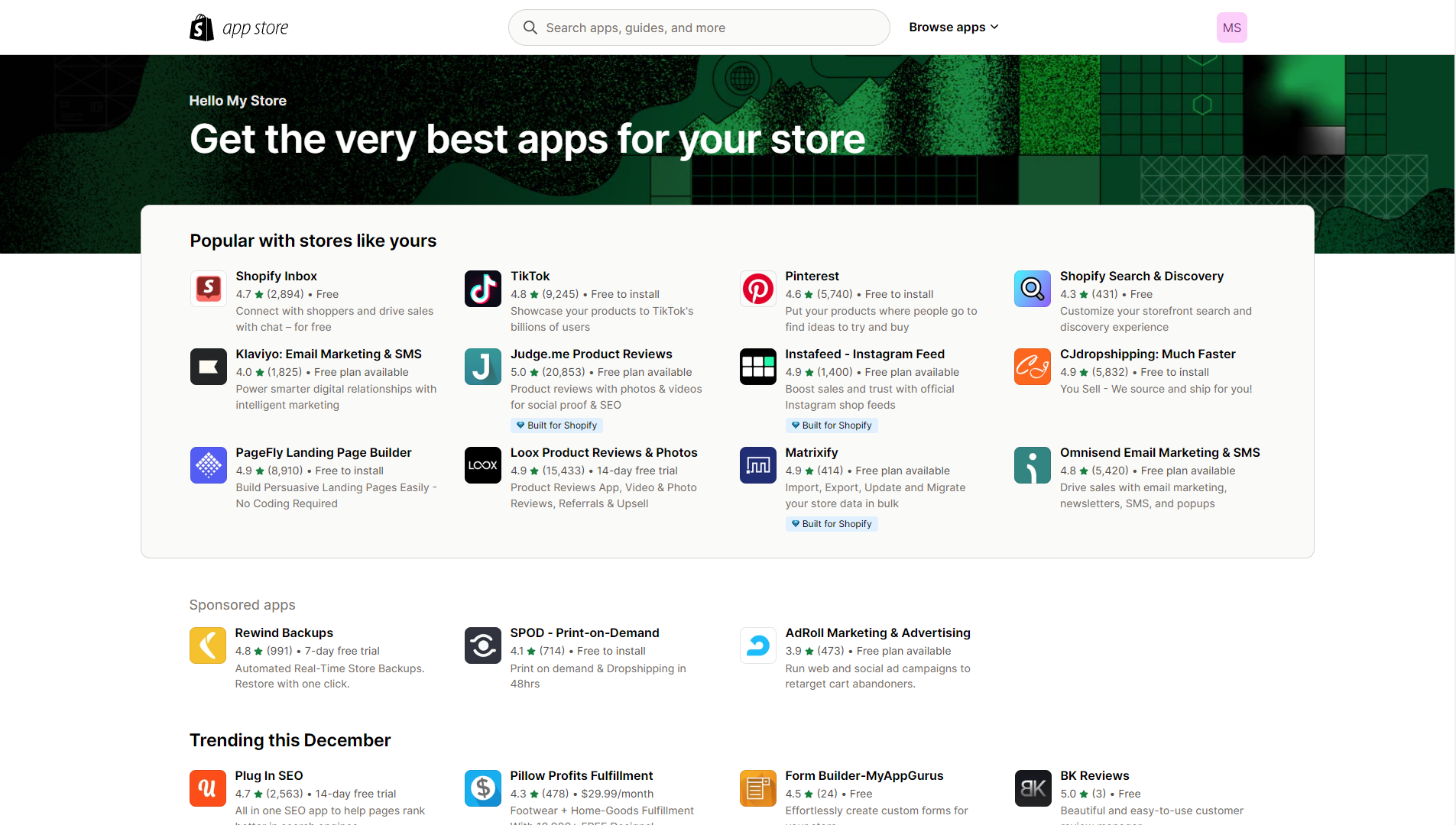
Marketing Features
Design FunctionalitiesRepresents how well each platform allows for creative design and customization of websites.Score Components:
- Template Variety (30%): Range and quality of design templates.
- Customization (30%): Flexibility and options for design alterations.
- User Interface (20%): Ease and intuitiveness of the design process.
- Responsiveness (10%): Adaptability to different devices and screen sizes.
- Innovation (10%): Unique design features and tools.
 8.8
8.8
 7.1
7.1
🏆
Overall Winner: Shopify
. Shopify stands out for its more advanced ecommerce-focused marketing tools, especially in analytics and ad campaign management. Sellfy, while offering a good range of features, lacks blogging capabilities which can be a crucial aspect of a comprehensive marketing strategy.

|

|
|
|---|---|---|
|
SEO Tools |
|
|
|
Email Marketing |
|
|
|
Blogging |
|
|
|
Social Media Integration |
Advanced integration for selling directly on social platforms |
Basic integration for selling directly on social platforms |
|
Analytics and Reporting |
Detailed analytics for in-depth insights |
Basic analytics for website traffic and engagement |
|
Ads and Promotions |
Google Ads integration; sophisticated ad campaign management |
Basic ad campaign management and promotions |
Customer Support
Customer supportEvaluates the quality and availability of support options.Score Components:
- Response time (40%): Speed of support responses.
- Support quality (30%): Effectiveness and helpfulness of the support.
- Availability (20%): Range of support channels (phone, chat, email).
- Resource richness (10%): Quality of self-help and educational materials.
 8.6
8.6
 5.8
5.8
🏆 Winner: Shopify
. Comparing Shopify vs Sellfy, Shopify stands out with its comprehensive 24/7 customer support through chat, email, and phone. Shopify’s support is highly praised for its responsiveness and the extensive resources available, including tutorials, forums, and a marketing blog that offers valuable business growth strategies. Additionally, Shopify provides dedicated enterprise support with features like a dedicated account manager and priority support.
Sellfy, on the other hand, offers 24/7 customer support but lacks phone and live chat options, limiting users to email and possibly a knowledge base for self-service. While Sellfy’s support is available around the clock, the lack of diverse support channels can be a drawback for users needing immediate assistance. Furthermore, Sellfy does not offer specialized support for enterprise-level businesses, making Shopify the more robust option for comprehensive customer support.
Security
SecurityLooks at the platforms’ security measures and data protection.Score Components:
- Data protection (40%): Safeguards for user and customer data.
- SSL and encryption (30%): Implementation of secure connections.
- Compliance (20%): Adherence to industry security standards.
- Regular updates (10%): Frequency of security updates and patches.
 9.0
9.0
 7.2
7.2
🏆
Winner: Shopify
. Shopify’s security measures are more comprehensive, including secure infrastructure, encryption, limited access, compliance with data privacy regulations, data minimization, user control and transparency, two-factor authentication, regular audits, and a dedicated incident response team. These features provide a high level of security for both store owners and customers.
Sellfy, while offering security measures such as PDF stamping and limited download attempts to protect digital content, acknowledges the challenges of completely eliminating piracy in the digital space. It uses secure payment processors like Stripe and PayPal, provides unique download links for each purchase, and offers tools to handle disputes effectively. However, its security score is lower than Shopify’s, indicating that its security measures may not be as robust.
AI Capabilities
AI capabilitiesMeasures the effectiveness of AI-driven features and tools.Score Components:
- Automation efficiency (40%): Impact of AI on streamlining processes.
- Personalization (30%): AI-driven customization for users or customers.
- AI-Assisted design (20%): Role of AI in website design and functionality.
- Data analysis (10%): Use of AI in interpreting user data and analytics.
 7.9
7.9
 0
0

|

|
|
|---|---|---|
|
Personalized Design |
Shopify AI Builder offers personalized design suggestions |
|
|
SEO Optimization |
AI-driven recommendations for better search engine visibility |
|
|
Customer Behavior Analysis |
Advanced analytics to understand customer preferences |
|
|
Sales Predictions |
AI-powered sales forecasting tools |
|
|
Inventory Management |
AI tools to assist in efficient inventory handling |
|
|
Content Generation |
AI assistance in creating and optimizing site content |
|
🏆 Winner: Shopify
. Shopify, with a score of 7.9, utilizes AI mainly to enhance the ecommerce experience. Its AI features focus on customer behavior analysis, personalized shopping experiences, inventory management, and sales predictions. Shopify’s AI is powerful and offers a range of capabilities to assist in managing an online store.
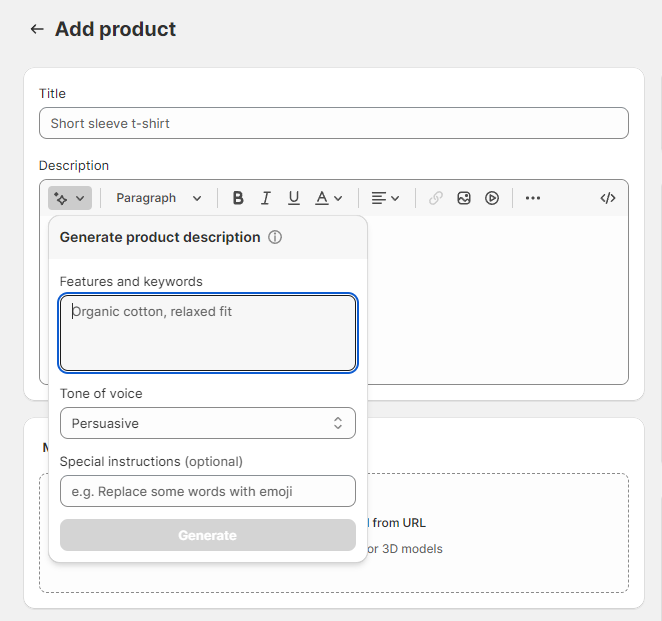
Sellfy, on the other hand, does not have any AI capabilities. This means that while it may offer a user-friendly interface and a comprehensive set of tools for managing an online store, it lacks the advanced AI features that Shopify provides.
User Management
User ManagementAssesses the platforms’ capabilities in managing user roles, permissions, and accessibility.Score Components:
- Role Customization (40%): Flexibility in creating and defining user roles and
permissions. - Ease of Management (30%): User interface and tools for managing users.
- Access Control (20%): Effectiveness of access control measures for different user
levels. - Scalability (10%): Ability to manage a growing number of users efficiently.
 6.5
6.5
 2.0
2.0
🏆 Winner: Shopify
. Shopify offers a more robust user management system compared to Sellfy.
- Shopify allows for different roles with varying levels of access, including Store Owner, Staff, and Collaborator. This makes it easier to manage a team and delegate tasks.
- Sellfy, on the other hand, does not support adding multiple users or staff to a single account. This can limit the platform’s usability for larger teams or businesses.
Shopify User Roles and Access Levels:
| Role | Description | Access Highlights |
|---|---|---|
| Store Owner | Full control over store | Manage products, orders, discounts, payments, apps, settings. Create and manage staff accounts. |
| Staff | Configurable access by owner | Add/edit products, manage orders, fulfill orders, manage customers, update content. Access level can be customized by the owner. |
| Collaborator | Limited access for external partners | View and manage specific sections like blog or product categories. Cannot access full store settings. |
Sellfy does not provide user roles and access levels.
Additional Features

|

|
|
|---|---|---|
|
SSL Certificate |
|
|
|
Custom Domain |
|
|
|
Free Custom Domain Included |
|
|
|
International Domains |
|
|
|
Mobile Responsive |
|
|
|
Page Speed |
|
|
|
Website Builder Mobile App |
|
|
|
Convert a Website To An App |
|
|
|
Website Analytics |
|
|
|
Multilingual Sites |
|
|
|
Multiple Users |
|
|
User Feedback
Shopify’s slightly higher rating on G2 Crowd can be largely attributed to its specialization in ecommerce. Its comprehensive features, ease of use, and robust customer support cater specifically to online businesses, leading to high user satisfaction among those seeking a dedicated ecommerce solution.
The user feedback on Sellfy highlights its strengths in providing an efficient, compact online store setup that caters to specific needs with affordable pricing, including a 14-day trial period to familiarize users with the product. Many appreciate its user-friendly interface, internal marketing tools, and customization options, which enable sellers to tailor their storefronts to their brand, along with integrations for payment processing like PayPal and Stripe. However, criticisms include issues with mobile site speed, a desire for clearer insights, limitations on customization, and some customer service inefficiencies.
The making of this blog
We followed a clear, step-by-step process to write and research this article.
FAQ
Which platform is better for ecommerce, Shopify or Sellfy?
Can I use Shopify or Sellfy to sell digital products?
Which platform offers better design and customization options?
Is Sellfy easier to use than Shopify?
How do Shopify and Sellfy compare in terms of price?
Which platform provides better customer support?
Are there any differences in hosting quality between Shopify and Sellfy?
Can I manage multiple users with Shopify and Sellfy?
Which platform is better for marketing and SEO?
How do Shopify and Sellfy handle security?










